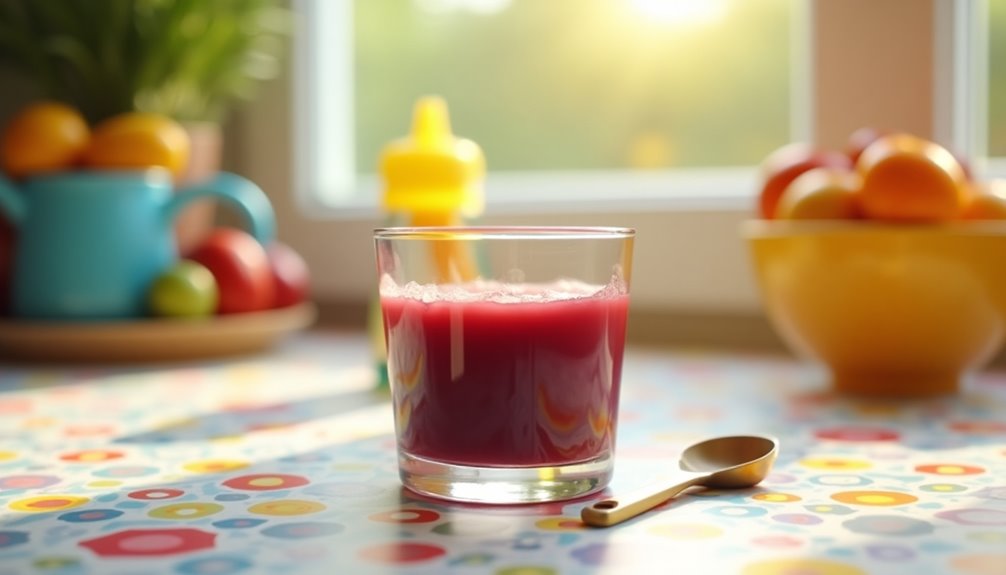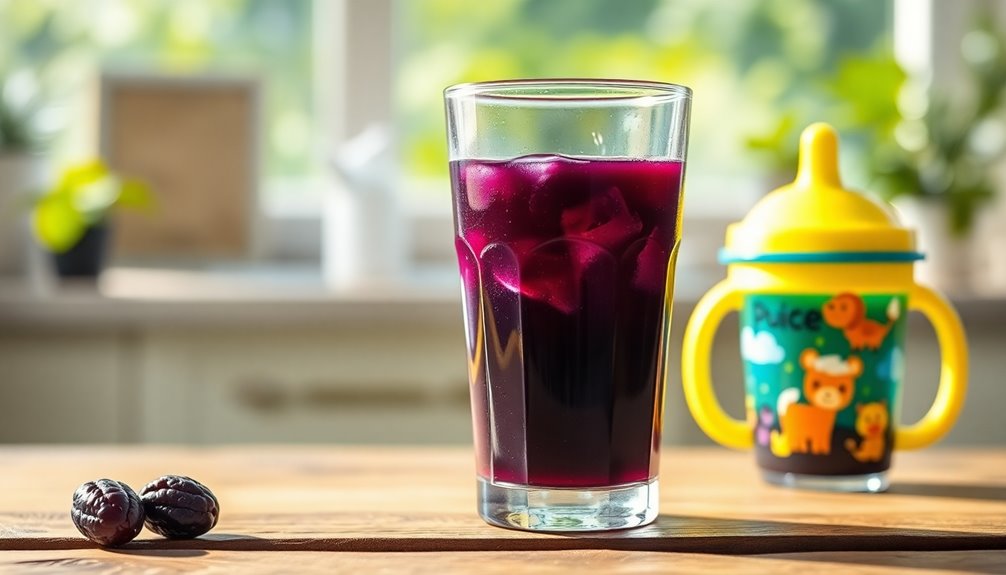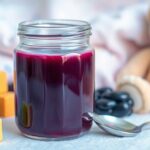For your 2-year-old, you can give up to 4 ounces (118 ml) of prune juice per day to help relieve constipation. Start with 1 ounce to see how they react, then gradually increase if all goes well. It's best to serve it undiluted and monitor for any stomach issues. Remember, a balanced diet rich in fiber is crucial for digestive health, and there's more to know to support your child's digestive needs effectively.
Key Takeaways
- A 2-year-old can have up to 4 ounces (118 ml) of prune juice per day, ideally undiluted.
- Start with 1 ounce and gradually increase based on the child's tolerance and reactions.
- Monitor for any adverse reactions like stomach irritation or diarrhea, and adjust accordingly.
- Prune juice should be part of a balanced diet rich in fiber, including fruits and leafy greens.
- Consult a pediatrician for personalized advice, especially if the child has underlying health concerns.

When it comes to giving prune juice to your 2-year-old, up to 4 ounces (118 ml) per day is the recommended amount, ideally served undiluted. Prune juice is known for its natural laxative effects, making it a popular choice for parents dealing with constipation in young children. However, it’s essential to introduce this juice gradually to ensure your child tolerates it well. Start by offering just 1 ounce and observe how your little one reacts. If everything goes smoothly, you can increase the amount as needed to help relieve constipation. It’s also beneficial to maintain a balanced diet rich in fiber alongside prune juice to support healthy digestion. When considering how to serve prune juice, you might want to mix it with other fruit juices or water if your child prefers a milder taste, but always keep the concentration mostly intact. Monitoring your child’s response will help you gauge the best approach for their individual needs.
Incorporating prune juice into your child's diet should be part of a broader approach to maintaining regular bowel movements. While prune juice can be effective, it shouldn't be the only solution. A balanced diet, rich in fiber from fruits and vegetables, is crucial for your 2-year-old's digestive health. Foods like apples, pears, and leafy greens can complement the effects of prune juice, providing a well-rounded nutritional intake that supports bowel regularity.
As you introduce prune juice, keep an eye on your child. Monitoring for any adverse reactions is vital, especially during the initial days. Some children may experience stomach irritation or diarrhea, which could be a sign that the amount is too high or that they're not ready for it yet. If your child does have any negative reactions, scale back the amount and consult with a pediatrician.
It's always a good idea to involve a healthcare professional, particularly if your child has any underlying health concerns or dietary restrictions. Your pediatrician can offer personalized advice based on your child's specific needs. They may suggest alternatives or additional methods for tackling constipation. Remember, every child is different, and what works for one may not be suitable for another. By consulting with a pediatrician, you can ensure that you're taking the right steps in introducing prune juice safely and effectively.
As you navigate this process, aim for consistency. Offering prune juice regularly, within the recommended amount, can help establish a routine that promotes healthy digestion. In combination with a balanced diet, you'll be setting your child up for success in achieving regular bowel movements.
Ultimately, the goal is to create a supportive environment for your 2-year-old's digestive health. By gradually introducing prune juice and monitoring their response, you'll find the right balance that works for your family. With the right approach, prune juice can be a helpful aid in managing constipation while also encouraging a healthy and balanced diet.
Frequently Asked Questions
How Much Prune Juice Can I Give a 2 Year Old?
When considering how much prune juice to give your 2-year-old, it's best to start slowly. You can begin with 1 ounce and see how your child responds.
If needed, you can gradually increase it up to 4 ounces a day. Diluting the juice with water can also help if they're sensitive.
How Long After Prune Juice Will I Poop?
After drinking prune juice, you might wonder how long it'll take before you need to poop.
Generally, most people experience a bowel movement within 12 to 24 hours due to the juice's natural laxative effects.
However, don't be surprised if it takes a bit longer; factors like your diet and hydration play a role.
If you haven't gone within 24 hours, it's wise to check in with a healthcare provider to rule out any issues.
What Is the Best Juice for Constipation for a 2 Year Old?
When you're looking for the best juice for constipation in a 2-year-old, prune juice is a top choice. It contains sorbitol, which naturally helps soften stools.
You might also consider apple juice, as it has a similar effect. Diluting these juices with water can make them gentler on your child's stomach.
Always remember to pair juice with plenty of water and fiber-rich foods to support regular bowel movements effectively.
How Can I Help My 2 Year Old Poop When Constipated?
When your toddler's feeling backed up, it's time to take the bull by the horns.
Start by offering plenty of water and high-fiber foods like fruits and veggies to keep things moving. You can also try gentle tummy massages and warm baths to relax their muscles.
Establishing a regular toilet routine can help, too. Encourage them to sit on the toilet after meals for a few minutes, making it a comfortable experience.
Conclusion
So, how much prune juice is just right for your 2-year-old? While a small amount—about 1 to 2 ounces—can help with constipation, too much might lead to tummy troubles. It's fascinating to think that a simple fruit juice can have such a big impact on digestion. Remember, every child is unique, so it's always wise to consult your pediatrician before introducing any new remedy. Trust your instincts, and you'll find what works best for your little one!
Cindy thoroughly researches juicing trends, techniques, and recipes to provide readers with practical advice and inspiration. Her writing style is accessible, engaging, and designed to make complex concepts easy to understand. Cindy’s dedication to promoting the advantages of juicing shines through her work, empowering readers to make positive changes in their lives through the simple act of juicing.

















